HRMT 200: Compensation and Legal Issues at Reynolds Plastic Products
VerifiedAdded on 2023/06/14
|10
|2172
|498
Case Study
AI Summary
This case study examines the compensation practices of Reynolds Plastic Products, focusing on legal compliance and the effectiveness of their incentive programs. Part 1 identifies contraventions of Alberta's labor laws, such as underpaying employees and not paying overtime, and evaluates the appropriateness of current incentive compensation practices, highlighting issues like understaffing, delayed salaries, and overworking employees. It also delves into the legal requirements for compensation. Part 2 discusses the company's health benefits plan, emphasizing the importance of aligning compensation with organizational strategy, classifying job positions, and adhering to anti-discrimination laws in providing health benefits. The study concludes with recommendations for improving Reynolds Plastic Products' compensation and benefits strategies to foster a high-performance culture and ensure legal compliance. Desklib provides access to this full assignment solution and many other study resources.
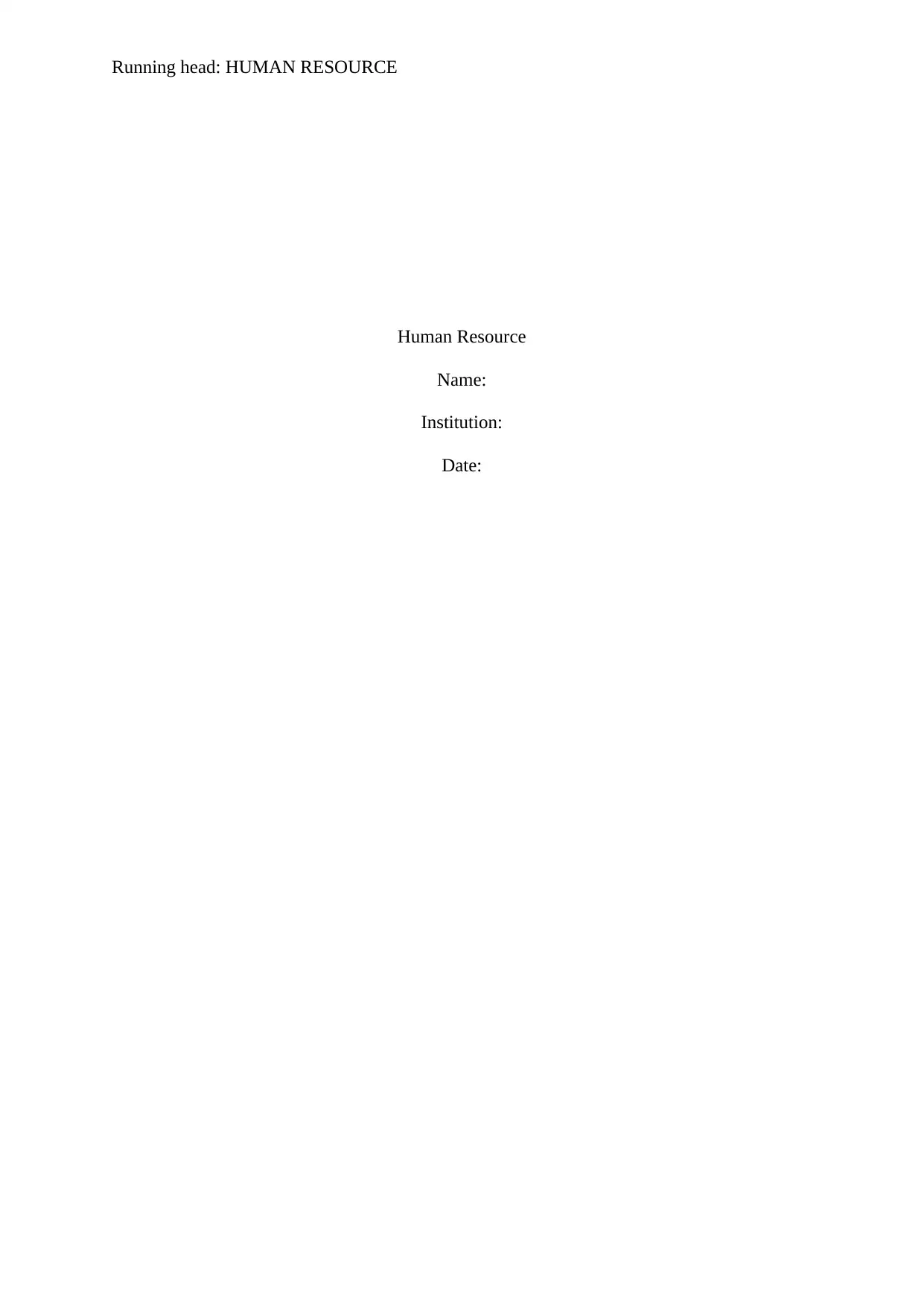
Running head: HUMAN RESOURCE
Human Resource
Name:
Institution:
Date:
Human Resource
Name:
Institution:
Date:
Paraphrase This Document
Need a fresh take? Get an instant paraphrase of this document with our AI Paraphraser
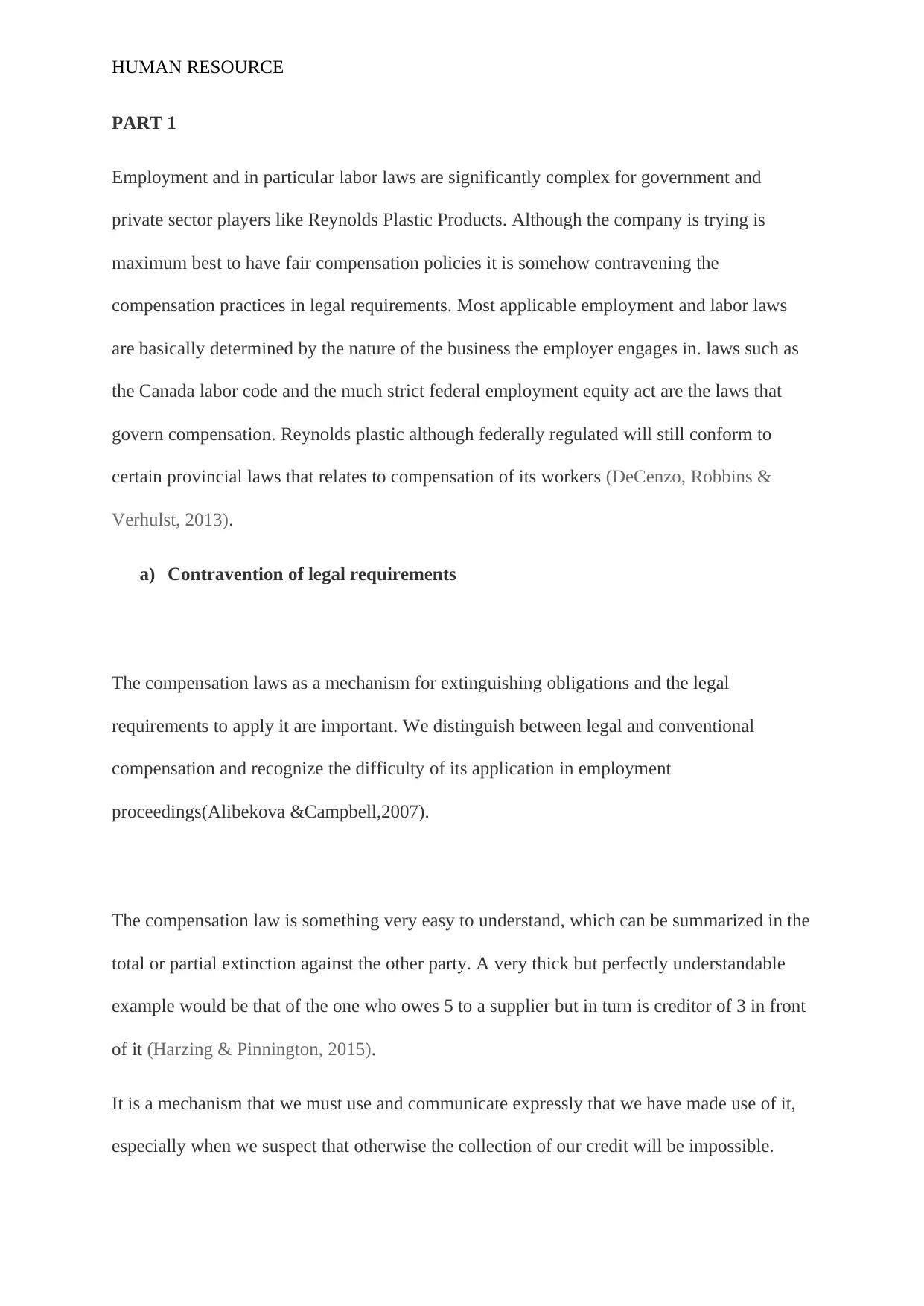
HUMAN RESOURCE
PART 1
Employment and in particular labor laws are significantly complex for government and
private sector players like Reynolds Plastic Products. Although the company is trying is
maximum best to have fair compensation policies it is somehow contravening the
compensation practices in legal requirements. Most applicable employment and labor laws
are basically determined by the nature of the business the employer engages in. laws such as
the Canada labor code and the much strict federal employment equity act are the laws that
govern compensation. Reynolds plastic although federally regulated will still conform to
certain provincial laws that relates to compensation of its workers (DeCenzo, Robbins &
Verhulst, 2013).
a) Contravention of legal requirements
The compensation laws as a mechanism for extinguishing obligations and the legal
requirements to apply it are important. We distinguish between legal and conventional
compensation and recognize the difficulty of its application in employment
proceedings(Alibekova &Campbell,2007).
The compensation law is something very easy to understand, which can be summarized in the
total or partial extinction against the other party. A very thick but perfectly understandable
example would be that of the one who owes 5 to a supplier but in turn is creditor of 3 in front
of it (Harzing & Pinnington, 2015).
It is a mechanism that we must use and communicate expressly that we have made use of it,
especially when we suspect that otherwise the collection of our credit will be impossible.
PART 1
Employment and in particular labor laws are significantly complex for government and
private sector players like Reynolds Plastic Products. Although the company is trying is
maximum best to have fair compensation policies it is somehow contravening the
compensation practices in legal requirements. Most applicable employment and labor laws
are basically determined by the nature of the business the employer engages in. laws such as
the Canada labor code and the much strict federal employment equity act are the laws that
govern compensation. Reynolds plastic although federally regulated will still conform to
certain provincial laws that relates to compensation of its workers (DeCenzo, Robbins &
Verhulst, 2013).
a) Contravention of legal requirements
The compensation laws as a mechanism for extinguishing obligations and the legal
requirements to apply it are important. We distinguish between legal and conventional
compensation and recognize the difficulty of its application in employment
proceedings(Alibekova &Campbell,2007).
The compensation law is something very easy to understand, which can be summarized in the
total or partial extinction against the other party. A very thick but perfectly understandable
example would be that of the one who owes 5 to a supplier but in turn is creditor of 3 in front
of it (Harzing & Pinnington, 2015).
It is a mechanism that we must use and communicate expressly that we have made use of it,
especially when we suspect that otherwise the collection of our credit will be impossible.
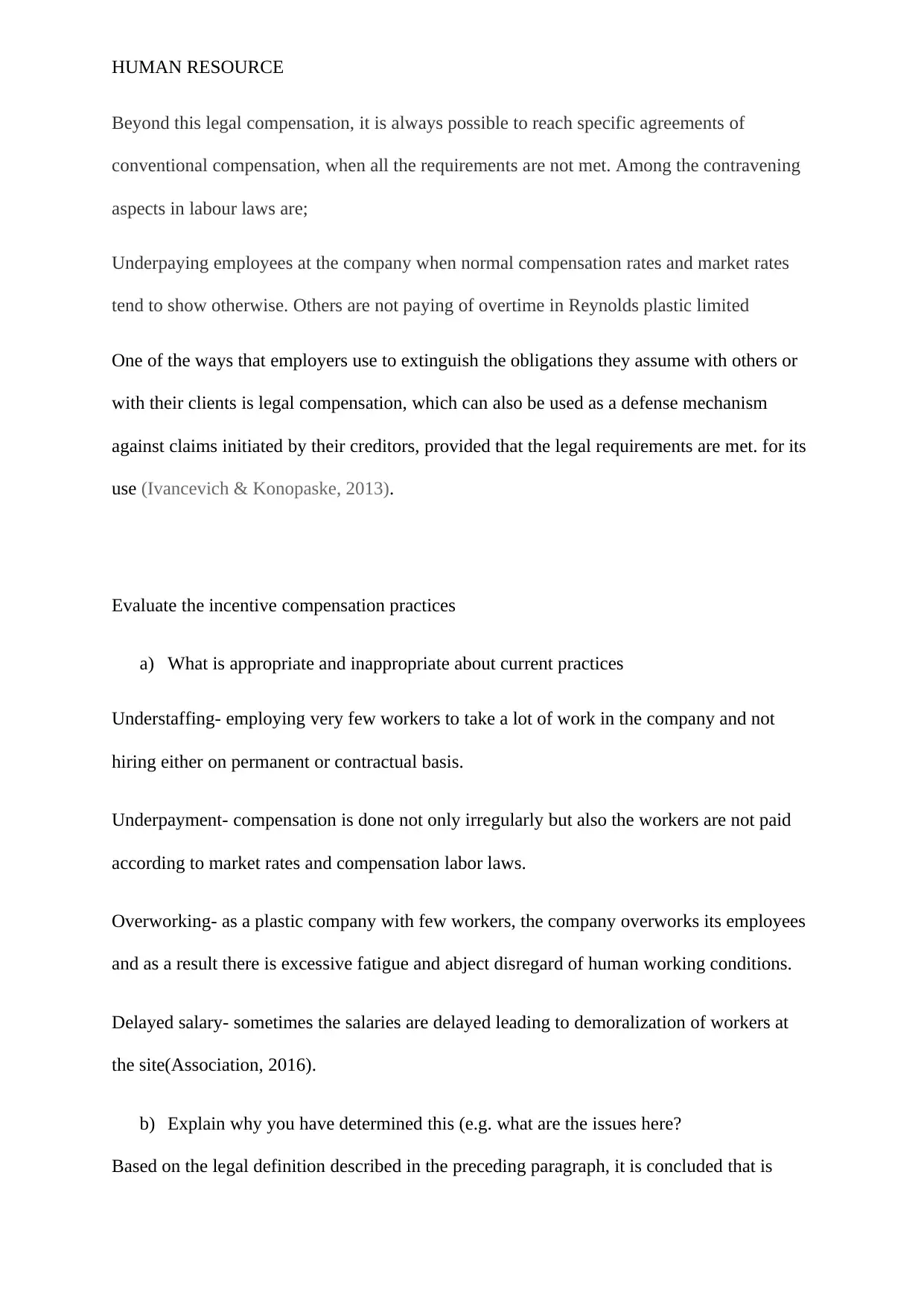
HUMAN RESOURCE
Beyond this legal compensation, it is always possible to reach specific agreements of
conventional compensation, when all the requirements are not met. Among the contravening
aspects in labour laws are;
Underpaying employees at the company when normal compensation rates and market rates
tend to show otherwise. Others are not paying of overtime in Reynolds plastic limited
One of the ways that employers use to extinguish the obligations they assume with others or
with their clients is legal compensation, which can also be used as a defense mechanism
against claims initiated by their creditors, provided that the legal requirements are met. for its
use (Ivancevich & Konopaske, 2013).
Evaluate the incentive compensation practices
a) What is appropriate and inappropriate about current practices
Understaffing- employing very few workers to take a lot of work in the company and not
hiring either on permanent or contractual basis.
Underpayment- compensation is done not only irregularly but also the workers are not paid
according to market rates and compensation labor laws.
Overworking- as a plastic company with few workers, the company overworks its employees
and as a result there is excessive fatigue and abject disregard of human working conditions.
Delayed salary- sometimes the salaries are delayed leading to demoralization of workers at
the site(Association, 2016).
b) Explain why you have determined this (e.g. what are the issues here?
Based on the legal definition described in the preceding paragraph, it is concluded that is
Beyond this legal compensation, it is always possible to reach specific agreements of
conventional compensation, when all the requirements are not met. Among the contravening
aspects in labour laws are;
Underpaying employees at the company when normal compensation rates and market rates
tend to show otherwise. Others are not paying of overtime in Reynolds plastic limited
One of the ways that employers use to extinguish the obligations they assume with others or
with their clients is legal compensation, which can also be used as a defense mechanism
against claims initiated by their creditors, provided that the legal requirements are met. for its
use (Ivancevich & Konopaske, 2013).
Evaluate the incentive compensation practices
a) What is appropriate and inappropriate about current practices
Understaffing- employing very few workers to take a lot of work in the company and not
hiring either on permanent or contractual basis.
Underpayment- compensation is done not only irregularly but also the workers are not paid
according to market rates and compensation labor laws.
Overworking- as a plastic company with few workers, the company overworks its employees
and as a result there is excessive fatigue and abject disregard of human working conditions.
Delayed salary- sometimes the salaries are delayed leading to demoralization of workers at
the site(Association, 2016).
b) Explain why you have determined this (e.g. what are the issues here?
Based on the legal definition described in the preceding paragraph, it is concluded that is
⊘ This is a preview!⊘
Do you want full access?
Subscribe today to unlock all pages.

Trusted by 1+ million students worldwide
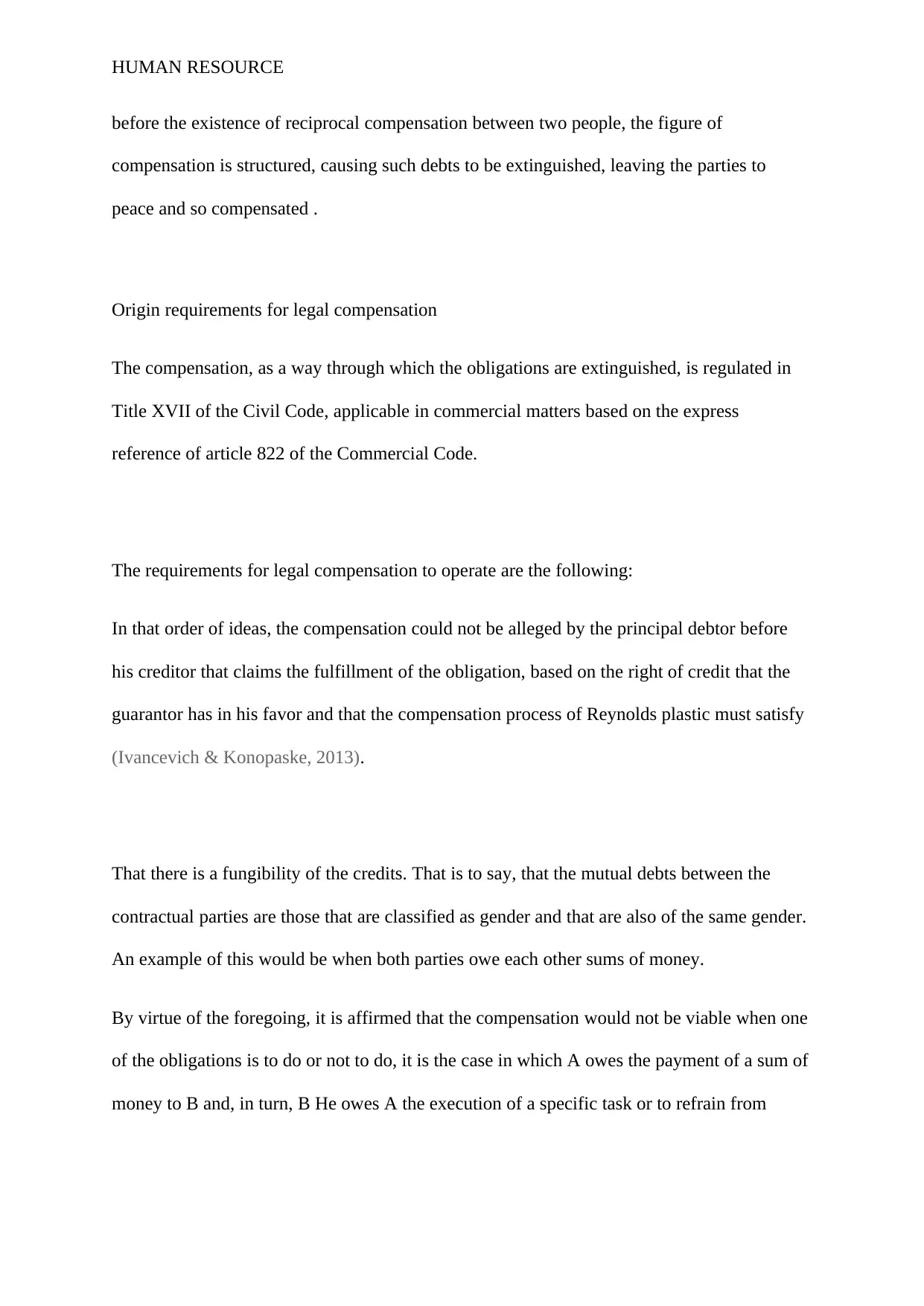
HUMAN RESOURCE
before the existence of reciprocal compensation between two people, the figure of
compensation is structured, causing such debts to be extinguished, leaving the parties to
peace and so compensated .
Origin requirements for legal compensation
The compensation, as a way through which the obligations are extinguished, is regulated in
Title XVII of the Civil Code, applicable in commercial matters based on the express
reference of article 822 of the Commercial Code.
The requirements for legal compensation to operate are the following:
In that order of ideas, the compensation could not be alleged by the principal debtor before
his creditor that claims the fulfillment of the obligation, based on the right of credit that the
guarantor has in his favor and that the compensation process of Reynolds plastic must satisfy
(Ivancevich & Konopaske, 2013).
That there is a fungibility of the credits. That is to say, that the mutual debts between the
contractual parties are those that are classified as gender and that are also of the same gender.
An example of this would be when both parties owe each other sums of money.
By virtue of the foregoing, it is affirmed that the compensation would not be viable when one
of the obligations is to do or not to do, it is the case in which A owes the payment of a sum of
money to B and, in turn, B He owes A the execution of a specific task or to refrain from
before the existence of reciprocal compensation between two people, the figure of
compensation is structured, causing such debts to be extinguished, leaving the parties to
peace and so compensated .
Origin requirements for legal compensation
The compensation, as a way through which the obligations are extinguished, is regulated in
Title XVII of the Civil Code, applicable in commercial matters based on the express
reference of article 822 of the Commercial Code.
The requirements for legal compensation to operate are the following:
In that order of ideas, the compensation could not be alleged by the principal debtor before
his creditor that claims the fulfillment of the obligation, based on the right of credit that the
guarantor has in his favor and that the compensation process of Reynolds plastic must satisfy
(Ivancevich & Konopaske, 2013).
That there is a fungibility of the credits. That is to say, that the mutual debts between the
contractual parties are those that are classified as gender and that are also of the same gender.
An example of this would be when both parties owe each other sums of money.
By virtue of the foregoing, it is affirmed that the compensation would not be viable when one
of the obligations is to do or not to do, it is the case in which A owes the payment of a sum of
money to B and, in turn, B He owes A the execution of a specific task or to refrain from
Paraphrase This Document
Need a fresh take? Get an instant paraphrase of this document with our AI Paraphraser
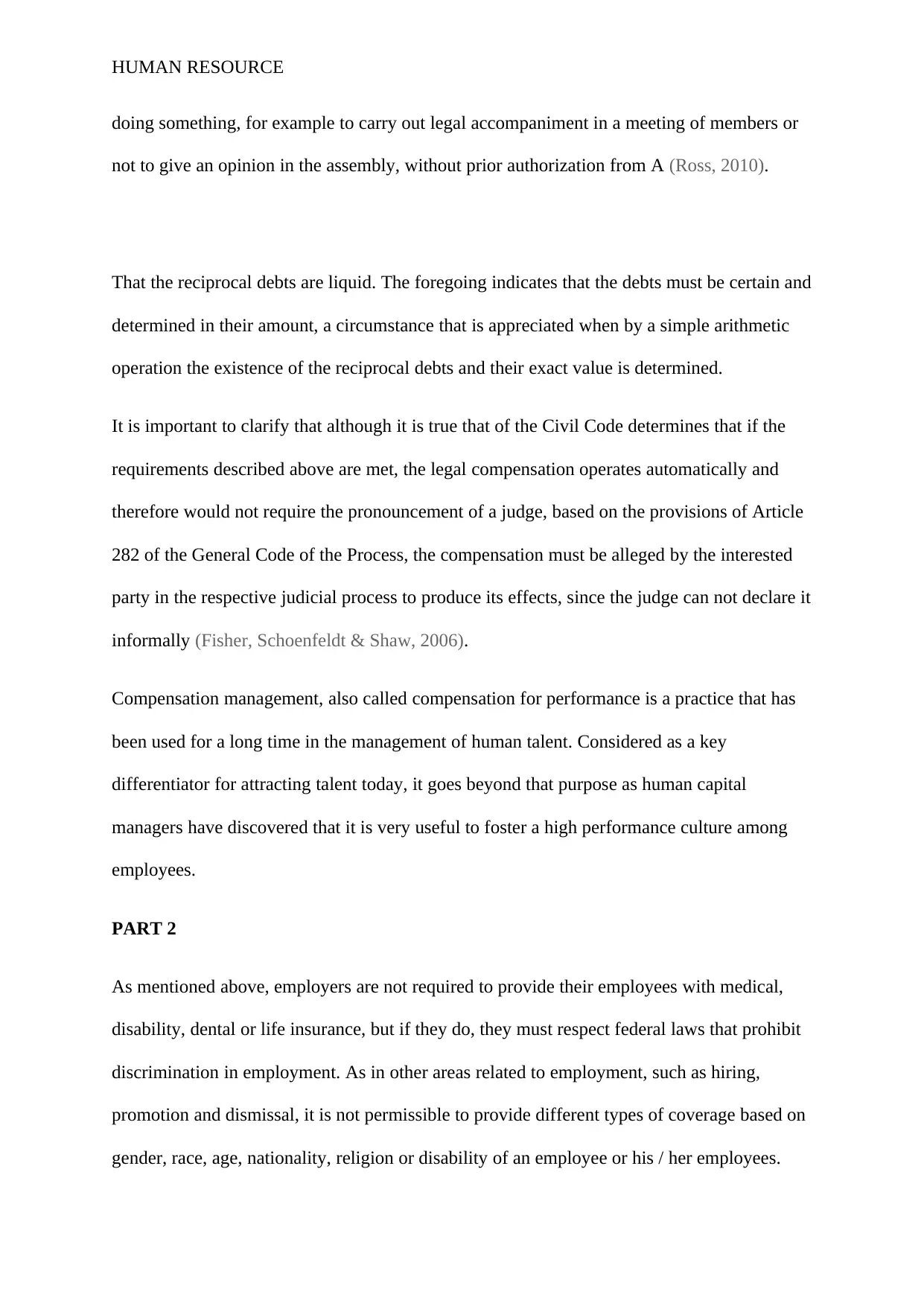
HUMAN RESOURCE
doing something, for example to carry out legal accompaniment in a meeting of members or
not to give an opinion in the assembly, without prior authorization from A (Ross, 2010).
That the reciprocal debts are liquid. The foregoing indicates that the debts must be certain and
determined in their amount, a circumstance that is appreciated when by a simple arithmetic
operation the existence of the reciprocal debts and their exact value is determined.
It is important to clarify that although it is true that of the Civil Code determines that if the
requirements described above are met, the legal compensation operates automatically and
therefore would not require the pronouncement of a judge, based on the provisions of Article
282 of the General Code of the Process, the compensation must be alleged by the interested
party in the respective judicial process to produce its effects, since the judge can not declare it
informally (Fisher, Schoenfeldt & Shaw, 2006).
Compensation management, also called compensation for performance is a practice that has
been used for a long time in the management of human talent. Considered as a key
differentiator for attracting talent today, it goes beyond that purpose as human capital
managers have discovered that it is very useful to foster a high performance culture among
employees.
PART 2
As mentioned above, employers are not required to provide their employees with medical,
disability, dental or life insurance, but if they do, they must respect federal laws that prohibit
discrimination in employment. As in other areas related to employment, such as hiring,
promotion and dismissal, it is not permissible to provide different types of coverage based on
gender, race, age, nationality, religion or disability of an employee or his / her employees.
doing something, for example to carry out legal accompaniment in a meeting of members or
not to give an opinion in the assembly, without prior authorization from A (Ross, 2010).
That the reciprocal debts are liquid. The foregoing indicates that the debts must be certain and
determined in their amount, a circumstance that is appreciated when by a simple arithmetic
operation the existence of the reciprocal debts and their exact value is determined.
It is important to clarify that although it is true that of the Civil Code determines that if the
requirements described above are met, the legal compensation operates automatically and
therefore would not require the pronouncement of a judge, based on the provisions of Article
282 of the General Code of the Process, the compensation must be alleged by the interested
party in the respective judicial process to produce its effects, since the judge can not declare it
informally (Fisher, Schoenfeldt & Shaw, 2006).
Compensation management, also called compensation for performance is a practice that has
been used for a long time in the management of human talent. Considered as a key
differentiator for attracting talent today, it goes beyond that purpose as human capital
managers have discovered that it is very useful to foster a high performance culture among
employees.
PART 2
As mentioned above, employers are not required to provide their employees with medical,
disability, dental or life insurance, but if they do, they must respect federal laws that prohibit
discrimination in employment. As in other areas related to employment, such as hiring,
promotion and dismissal, it is not permissible to provide different types of coverage based on
gender, race, age, nationality, religion or disability of an employee or his / her employees.
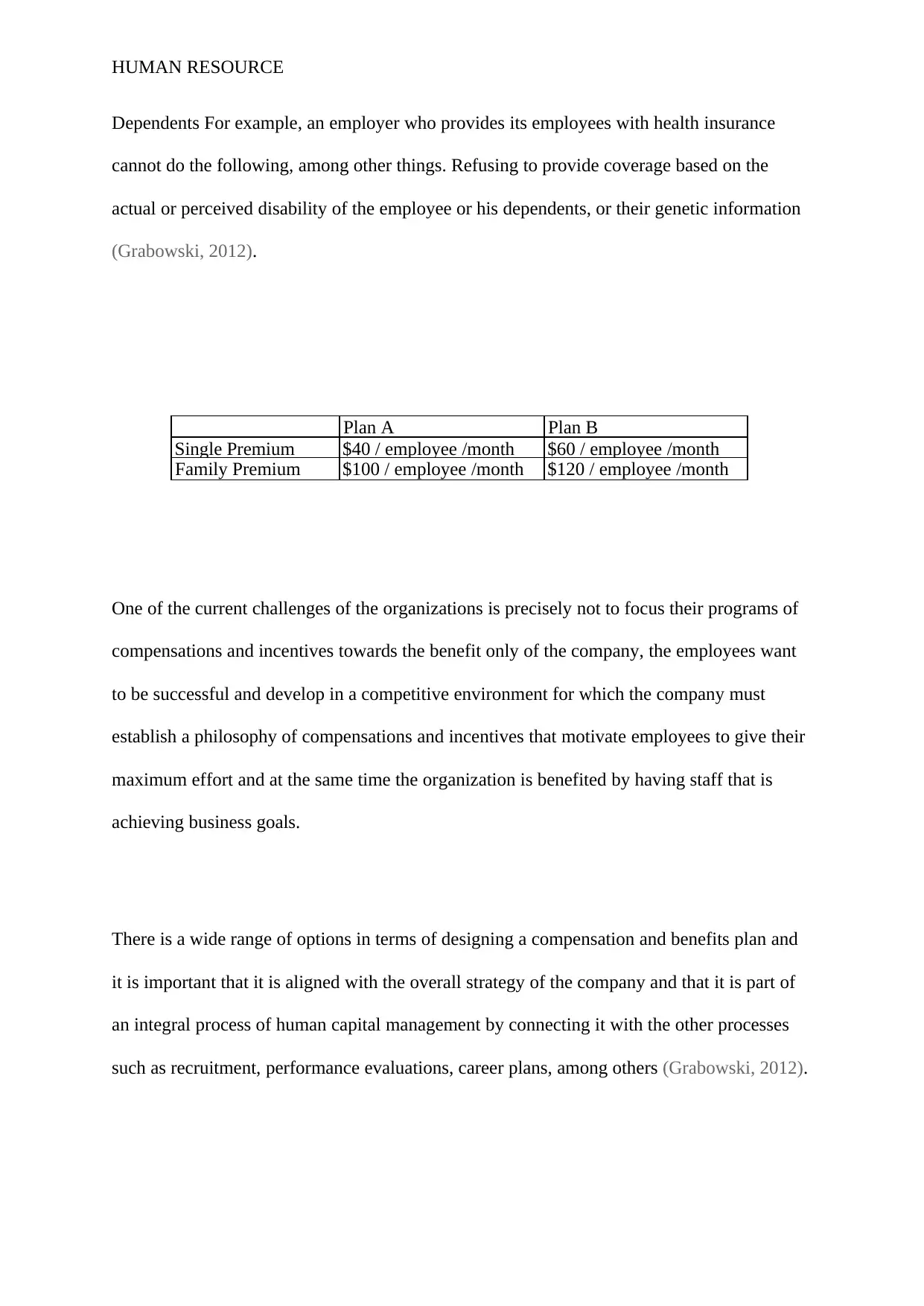
HUMAN RESOURCE
Dependents For example, an employer who provides its employees with health insurance
cannot do the following, among other things. Refusing to provide coverage based on the
actual or perceived disability of the employee or his dependents, or their genetic information
(Grabowski, 2012).
Plan A Plan B
Single Premium $40 / employee /month $60 / employee /month
Family Premium $100 / employee /month $120 / employee /month
One of the current challenges of the organizations is precisely not to focus their programs of
compensations and incentives towards the benefit only of the company, the employees want
to be successful and develop in a competitive environment for which the company must
establish a philosophy of compensations and incentives that motivate employees to give their
maximum effort and at the same time the organization is benefited by having staff that is
achieving business goals.
There is a wide range of options in terms of designing a compensation and benefits plan and
it is important that it is aligned with the overall strategy of the company and that it is part of
an integral process of human capital management by connecting it with the other processes
such as recruitment, performance evaluations, career plans, among others (Grabowski, 2012).
Dependents For example, an employer who provides its employees with health insurance
cannot do the following, among other things. Refusing to provide coverage based on the
actual or perceived disability of the employee or his dependents, or their genetic information
(Grabowski, 2012).
Plan A Plan B
Single Premium $40 / employee /month $60 / employee /month
Family Premium $100 / employee /month $120 / employee /month
One of the current challenges of the organizations is precisely not to focus their programs of
compensations and incentives towards the benefit only of the company, the employees want
to be successful and develop in a competitive environment for which the company must
establish a philosophy of compensations and incentives that motivate employees to give their
maximum effort and at the same time the organization is benefited by having staff that is
achieving business goals.
There is a wide range of options in terms of designing a compensation and benefits plan and
it is important that it is aligned with the overall strategy of the company and that it is part of
an integral process of human capital management by connecting it with the other processes
such as recruitment, performance evaluations, career plans, among others (Grabowski, 2012).
⊘ This is a preview!⊘
Do you want full access?
Subscribe today to unlock all pages.

Trusted by 1+ million students worldwide
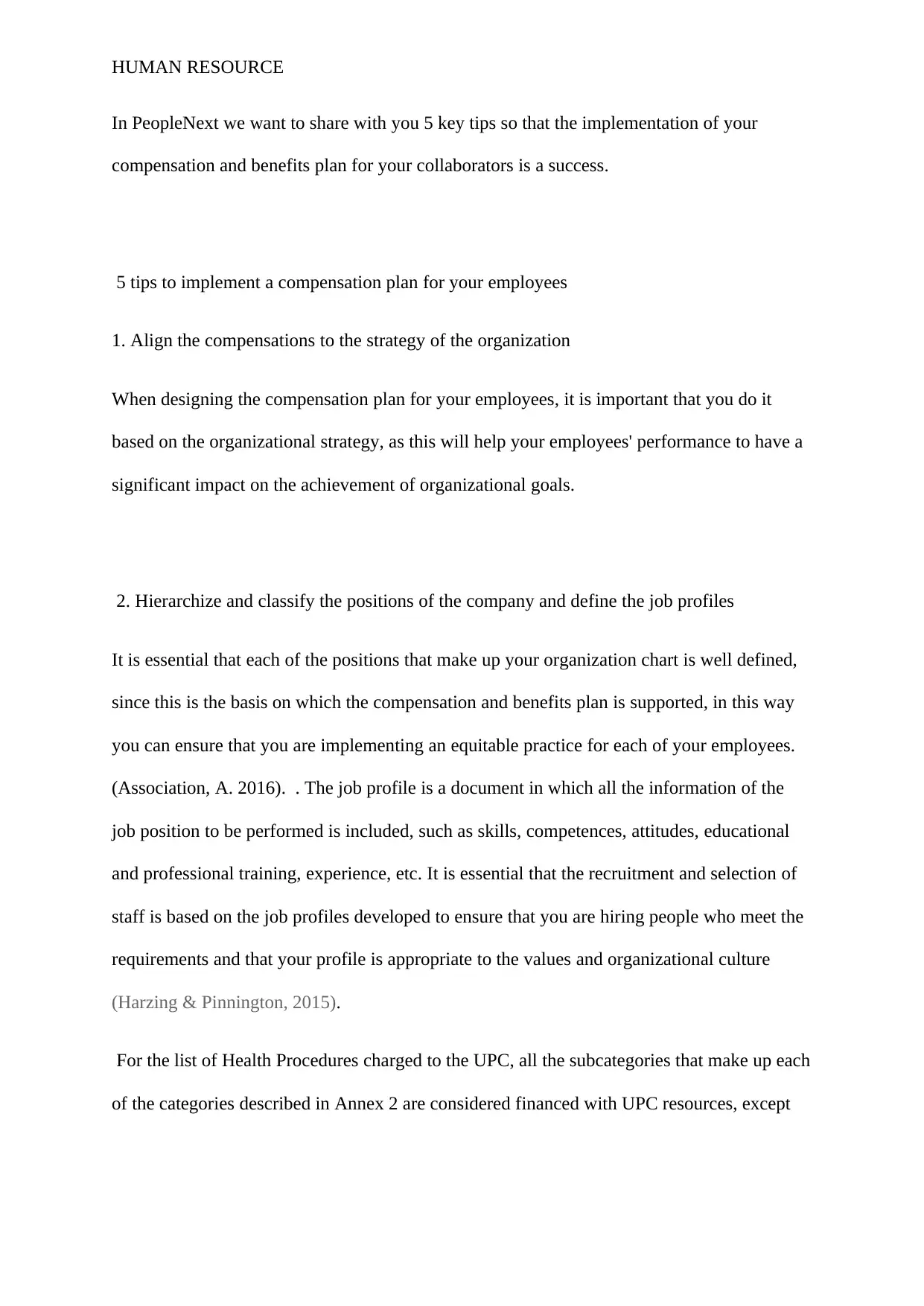
HUMAN RESOURCE
In PeopleNext we want to share with you 5 key tips so that the implementation of your
compensation and benefits plan for your collaborators is a success.
5 tips to implement a compensation plan for your employees
1. Align the compensations to the strategy of the organization
When designing the compensation plan for your employees, it is important that you do it
based on the organizational strategy, as this will help your employees' performance to have a
significant impact on the achievement of organizational goals.
2. Hierarchize and classify the positions of the company and define the job profiles
It is essential that each of the positions that make up your organization chart is well defined,
since this is the basis on which the compensation and benefits plan is supported, in this way
you can ensure that you are implementing an equitable practice for each of your employees.
(Association, A. 2016). . The job profile is a document in which all the information of the
job position to be performed is included, such as skills, competences, attitudes, educational
and professional training, experience, etc. It is essential that the recruitment and selection of
staff is based on the job profiles developed to ensure that you are hiring people who meet the
requirements and that your profile is appropriate to the values and organizational culture
(Harzing & Pinnington, 2015).
For the list of Health Procedures charged to the UPC, all the subcategories that make up each
of the categories described in Annex 2 are considered financed with UPC resources, except
In PeopleNext we want to share with you 5 key tips so that the implementation of your
compensation and benefits plan for your collaborators is a success.
5 tips to implement a compensation plan for your employees
1. Align the compensations to the strategy of the organization
When designing the compensation plan for your employees, it is important that you do it
based on the organizational strategy, as this will help your employees' performance to have a
significant impact on the achievement of organizational goals.
2. Hierarchize and classify the positions of the company and define the job profiles
It is essential that each of the positions that make up your organization chart is well defined,
since this is the basis on which the compensation and benefits plan is supported, in this way
you can ensure that you are implementing an equitable practice for each of your employees.
(Association, A. 2016). . The job profile is a document in which all the information of the
job position to be performed is included, such as skills, competences, attitudes, educational
and professional training, experience, etc. It is essential that the recruitment and selection of
staff is based on the job profiles developed to ensure that you are hiring people who meet the
requirements and that your profile is appropriate to the values and organizational culture
(Harzing & Pinnington, 2015).
For the list of Health Procedures charged to the UPC, all the subcategories that make up each
of the categories described in Annex 2 are considered financed with UPC resources, except
Paraphrase This Document
Need a fresh take? Get an instant paraphrase of this document with our AI Paraphraser
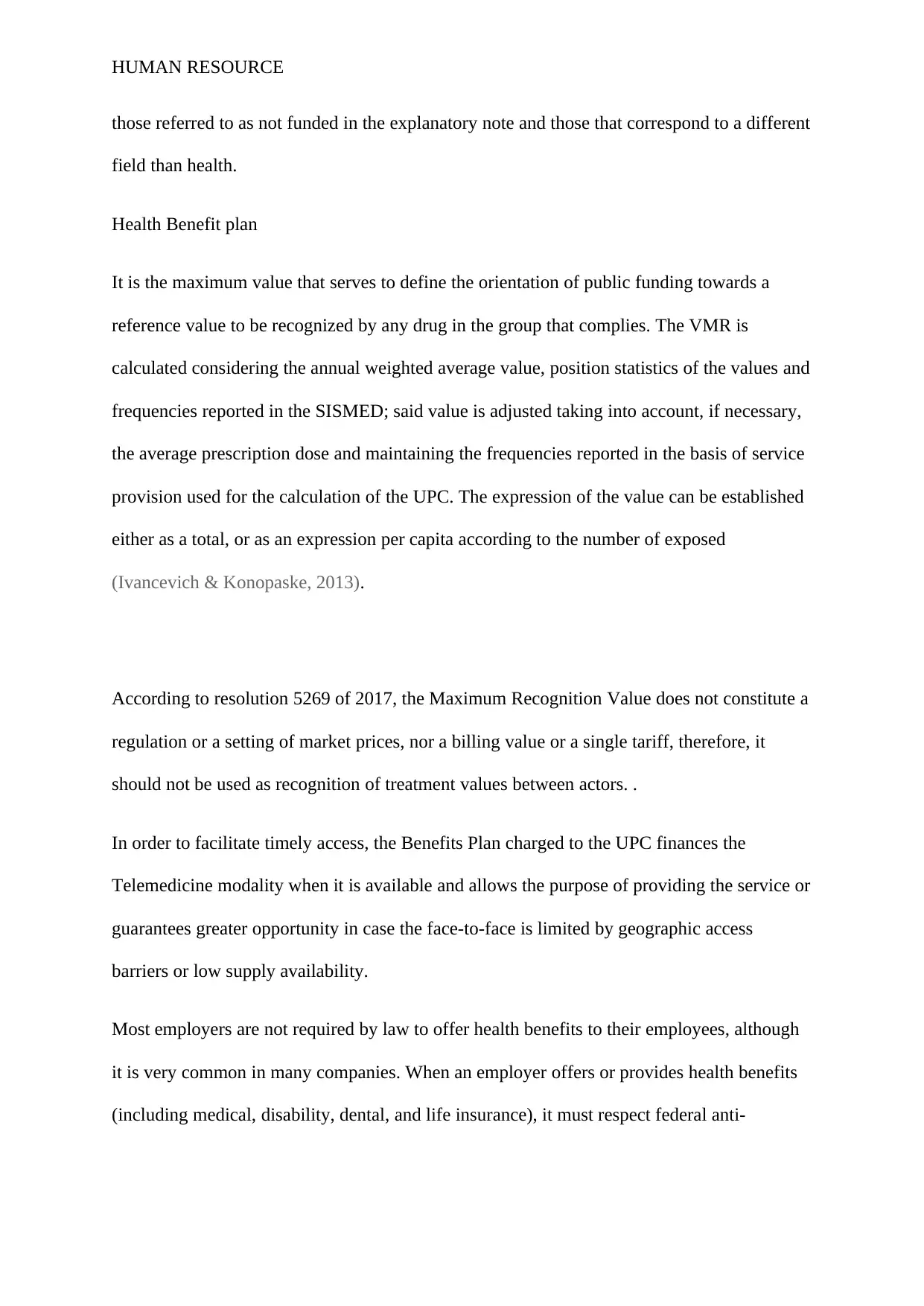
HUMAN RESOURCE
those referred to as not funded in the explanatory note and those that correspond to a different
field than health.
Health Benefit plan
It is the maximum value that serves to define the orientation of public funding towards a
reference value to be recognized by any drug in the group that complies. The VMR is
calculated considering the annual weighted average value, position statistics of the values and
frequencies reported in the SISMED; said value is adjusted taking into account, if necessary,
the average prescription dose and maintaining the frequencies reported in the basis of service
provision used for the calculation of the UPC. The expression of the value can be established
either as a total, or as an expression per capita according to the number of exposed
(Ivancevich & Konopaske, 2013).
According to resolution 5269 of 2017, the Maximum Recognition Value does not constitute a
regulation or a setting of market prices, nor a billing value or a single tariff, therefore, it
should not be used as recognition of treatment values between actors. .
In order to facilitate timely access, the Benefits Plan charged to the UPC finances the
Telemedicine modality when it is available and allows the purpose of providing the service or
guarantees greater opportunity in case the face-to-face is limited by geographic access
barriers or low supply availability.
Most employers are not required by law to offer health benefits to their employees, although
it is very common in many companies. When an employer offers or provides health benefits
(including medical, disability, dental, and life insurance), it must respect federal anti-
those referred to as not funded in the explanatory note and those that correspond to a different
field than health.
Health Benefit plan
It is the maximum value that serves to define the orientation of public funding towards a
reference value to be recognized by any drug in the group that complies. The VMR is
calculated considering the annual weighted average value, position statistics of the values and
frequencies reported in the SISMED; said value is adjusted taking into account, if necessary,
the average prescription dose and maintaining the frequencies reported in the basis of service
provision used for the calculation of the UPC. The expression of the value can be established
either as a total, or as an expression per capita according to the number of exposed
(Ivancevich & Konopaske, 2013).
According to resolution 5269 of 2017, the Maximum Recognition Value does not constitute a
regulation or a setting of market prices, nor a billing value or a single tariff, therefore, it
should not be used as recognition of treatment values between actors. .
In order to facilitate timely access, the Benefits Plan charged to the UPC finances the
Telemedicine modality when it is available and allows the purpose of providing the service or
guarantees greater opportunity in case the face-to-face is limited by geographic access
barriers or low supply availability.
Most employers are not required by law to offer health benefits to their employees, although
it is very common in many companies. When an employer offers or provides health benefits
(including medical, disability, dental, and life insurance), it must respect federal anti-
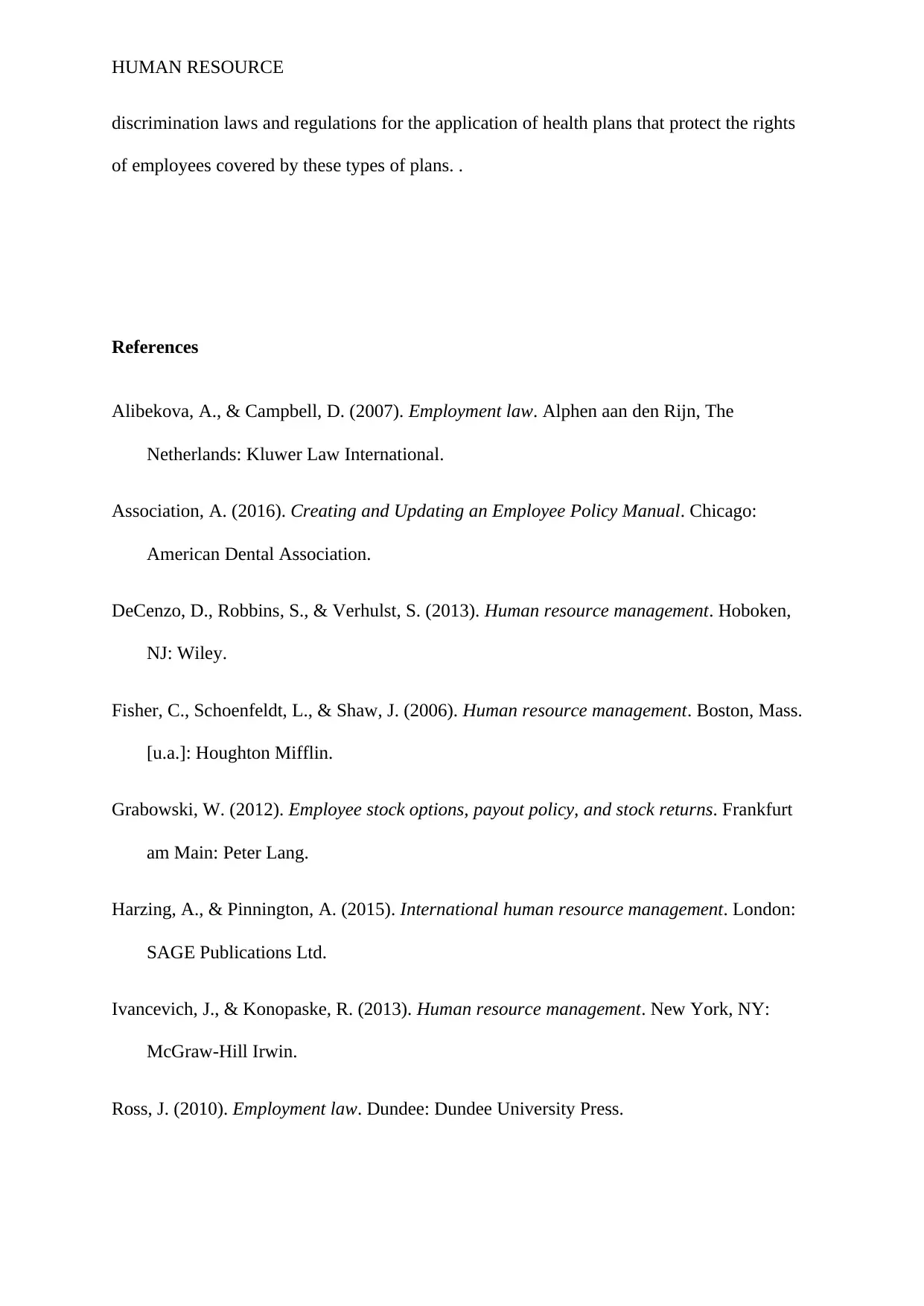
HUMAN RESOURCE
discrimination laws and regulations for the application of health plans that protect the rights
of employees covered by these types of plans. .
References
Alibekova, A., & Campbell, D. (2007). Employment law. Alphen aan den Rijn, The
Netherlands: Kluwer Law International.
Association, A. (2016). Creating and Updating an Employee Policy Manual. Chicago:
American Dental Association.
DeCenzo, D., Robbins, S., & Verhulst, S. (2013). Human resource management. Hoboken,
NJ: Wiley.
Fisher, C., Schoenfeldt, L., & Shaw, J. (2006). Human resource management. Boston, Mass.
[u.a.]: Houghton Mifflin.
Grabowski, W. (2012). Employee stock options, payout policy, and stock returns. Frankfurt
am Main: Peter Lang.
Harzing, A., & Pinnington, A. (2015). International human resource management. London:
SAGE Publications Ltd.
Ivancevich, J., & Konopaske, R. (2013). Human resource management. New York, NY:
McGraw-Hill Irwin.
Ross, J. (2010). Employment law. Dundee: Dundee University Press.
discrimination laws and regulations for the application of health plans that protect the rights
of employees covered by these types of plans. .
References
Alibekova, A., & Campbell, D. (2007). Employment law. Alphen aan den Rijn, The
Netherlands: Kluwer Law International.
Association, A. (2016). Creating and Updating an Employee Policy Manual. Chicago:
American Dental Association.
DeCenzo, D., Robbins, S., & Verhulst, S. (2013). Human resource management. Hoboken,
NJ: Wiley.
Fisher, C., Schoenfeldt, L., & Shaw, J. (2006). Human resource management. Boston, Mass.
[u.a.]: Houghton Mifflin.
Grabowski, W. (2012). Employee stock options, payout policy, and stock returns. Frankfurt
am Main: Peter Lang.
Harzing, A., & Pinnington, A. (2015). International human resource management. London:
SAGE Publications Ltd.
Ivancevich, J., & Konopaske, R. (2013). Human resource management. New York, NY:
McGraw-Hill Irwin.
Ross, J. (2010). Employment law. Dundee: Dundee University Press.
⊘ This is a preview!⊘
Do you want full access?
Subscribe today to unlock all pages.

Trusted by 1+ million students worldwide

HUMAN RESOURCE
1 out of 10
Your All-in-One AI-Powered Toolkit for Academic Success.
+13062052269
info@desklib.com
Available 24*7 on WhatsApp / Email
![[object Object]](/_next/static/media/star-bottom.7253800d.svg)
Unlock your academic potential
Copyright © 2020–2025 A2Z Services. All Rights Reserved. Developed and managed by ZUCOL.

